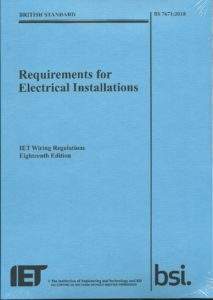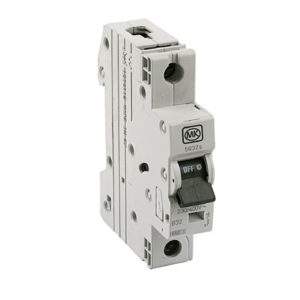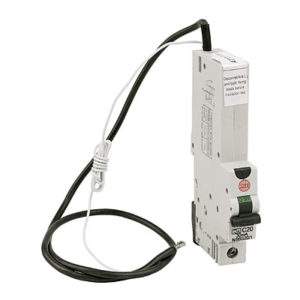Some terminology used in the electrical industry relating to regulations, methods of protection, testing and certifying electrical work, can be confusing to a homeowner. A few key phrases are explained here.
BS7671 & 18th Edition: BS7671 is the British standard reference number for the wiring regulations. It is updated and amended over time and the current edition, published in 2018, is called BS7671:2018 18th Edition. The previous 17th edition (BS7671:2008) was still valid until Dec 31 2018. All new work designed since Jan 01 2019 should comply with the current 18th edition. Sometimes an item may be described as 18th edition or BS7671 compliant, however any equipment is only compliant if it is installed and tested correctly in accordance with BS7671.
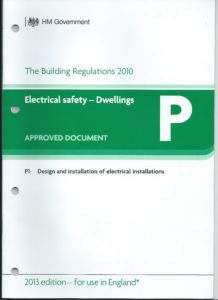 Part-P: Is one of many building regulations that must be adhered to during new building work, extensions and some minor works. They cover various aspects including; Structure, fire, ventilation, sanitation, conservation of fuel and power, access to buildings etc. Part-P specifically relates to electrical safety in dwellings. Some works that come within the remit of the building regulations, legally require a building regulations compliance certificate to be issued. With Part-P work this includes New circuits, New Consumer Units and some work in hazardous areas or rooms containing a bath or shower. An online version of Part-P guidance approved document can be downloaded from the following link;
Part-P: Is one of many building regulations that must be adhered to during new building work, extensions and some minor works. They cover various aspects including; Structure, fire, ventilation, sanitation, conservation of fuel and power, access to buildings etc. Part-P specifically relates to electrical safety in dwellings. Some works that come within the remit of the building regulations, legally require a building regulations compliance certificate to be issued. With Part-P work this includes New circuits, New Consumer Units and some work in hazardous areas or rooms containing a bath or shower. An online version of Part-P guidance approved document can be downloaded from the following link;
MCB: Miniature Circuit breaker, these are the modern replacement for the traditional wired fuse holders. They have a small switch which can be manually operated to disconnect the power to a circuit. Or in the event of an overload fault it will automatically operate the switch to disconnect the supply from the faulty cable/equipment. In simple terms an MCB or fuse disconnects the supply when too much electricity (current) is flowing along its normal path.
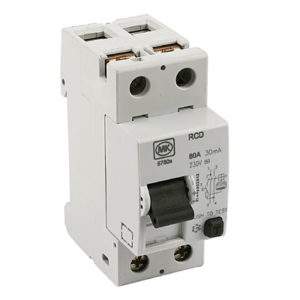 RCD: Residual Current Device, this is the generic name for a range of safety items that provide electric shock protection by detecting electrical current leaking out of a circuit. As with MCB’s RCD’s have a small switch which that will automatically disconnect the power in the event of a fault. They also have a test button that should be manually operated to verify the device is operational. In simple terms an RCD (also sometimes called an earth leakage breaker), disconnects the supply when a very small amount of electricity (current) is flowing where it should not flow, by leaving the circuit, maybe via an exposed metal part, or someone touching a live wire.
RCD: Residual Current Device, this is the generic name for a range of safety items that provide electric shock protection by detecting electrical current leaking out of a circuit. As with MCB’s RCD’s have a small switch which that will automatically disconnect the power in the event of a fault. They also have a test button that should be manually operated to verify the device is operational. In simple terms an RCD (also sometimes called an earth leakage breaker), disconnects the supply when a very small amount of electricity (current) is flowing where it should not flow, by leaving the circuit, maybe via an exposed metal part, or someone touching a live wire.
In a similar way that water flowing along a hosepipe should be equal as it enters and leaves the pipe, electric current 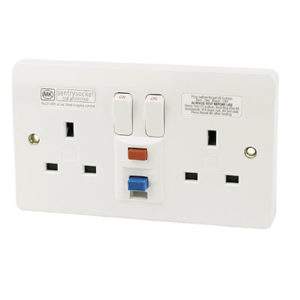
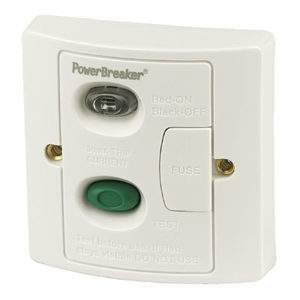 should also be equal as it flows into and out of a single circuit. In the event of electric shock some current will be leaking via the human body to earth and this imbalance can be detected by an RCD. RCD’s can be part of sockets or fused spurs as well as being built into a fuse box.
should also be equal as it flows into and out of a single circuit. In the event of electric shock some current will be leaking via the human body to earth and this imbalance can be detected by an RCD. RCD’s can be part of sockets or fused spurs as well as being built into a fuse box.
RCBO: Residual Current Breaker with Overload protection. This is a combined RCD and MCB.
CU: Consumer Unit, the modern name for the traditional ‘old’ fuse box, modern CU’s don’t actually have fuses they, have a combination of MCB’s. RCD’s and/or RCBO’s
Earthing: is used where electrical accessories have exposed metal parts that could become live during a fault condition. By maintaining a good connection to electrical earth this will ensure protective devices operate fast enough to remove the power and minimise danger.
Some items are double insulated (called ClassII) and  do not require earthing even though they may have some exposed metal. The symbol for ClassII equipment is two squares inside each other.
do not require earthing even though they may have some exposed metal. The symbol for ClassII equipment is two squares inside each other.
Bonding: is used where non electrical items, such as pipes or exposed structural metalwork could introduce an earth potential and provide a path for electrical current in the event of a fault. By maintaining a good connection to electrical earth this will reduce the possibility of a dangerous potential voltage building up between electrical earth and extraneous metalwork. Metal parts or plastic pipes which cannot introduce an earth potential do not need bonding.
Testing
Continuity and Polarity: Earth continuity is an essential requirement that must be verified at all accessory points. Even accessories that do not require a protective earth connection must have a earth conductor taken to them. An unused earth conductor must never be just cut off as supplies may be looped in and out of accessories to maintain continuity to the furthest part of the circuit. Sockets wired as a ring circuit must have the full continuity around the ring verified, Live to Live, Neutral to Neutral and Earth to Earth. Cables can be overloaded if part of a ring circuit continuity is broken. The polarity of Live and Neutral connections must be verified. A basic plug-in illuminated tester can give limited confirmation of polarity at a socket outlet. However they cannot identify a reversed Neutral and Earth connection, nor can they verify the continuity of a ring circuit. So they should not be relied upon to verify the safety of any circuit.
Insulation Resistance Test: Cables can be damaged during installation by squashing, stretching or piercing. Or can deteriorate after installation due to excessive loads or environmental conditions. Exposure to sunlight, heat, damp, vibration, adverse reaction from contact with other building materials, can all cause deterioration to cable insulation. The integrity of cables must be maintained to avoid risks of arcing, sparking, short circuit overload or electric shock.
Modern cables have PVC insulation that is durable and long lasting, whilst older installations may still have outdated rubber insulated cables. All cables, no matter what construction, should have their insulation tested before being energised, then at regular intervals while still in service. An insulation-resistance-test will verify the integrity of a cable proportional to the voltage it is expected to carry.
A cable with poor insulation may not show as a fault until someone gets a shock or an electrical fire is ignited. It can also cause intermittent operation of protective devices, during certain load conditions.
Earth Loop Impedance: In the event of a fault where an exposed metal part becomes live, a protective device must disconnect the supply quickly to minimise the risk of dangerous currents and associated heat building up to a level that could damage the cable or the building, And to prevent electric shock due to hazardous voltages being present on parts that people or livestock could touch. Overload protective devices have maximum ‘Earth Loop Impedances’, that circuits must not exceed to ensure the supply is disconnected fast enough in the event of a fault. These are listed in tables in the wiring regulations or from manufactures data sheets.
RCD Tests: RCD’s must have their operation tested to verify that are operating at the correct current rating and in the correct time. Too high a current, or too slow an operating time, could endanger people or livestock who come into contact with a live part. Also too low a current or too fast an operating time could result in nuisance tripping. An RCD test meter can record the operating times and current. In addition to the times and current every RCD has a test button which should be operated verify the physical trip mechanism has not seized.
Suitable calibrated meters for undertaking all of the essential electrical circuit tests would typically be £500 upwards. All of the various test results should be documented onto an appropriate electrical certificate for future reference, including the serial number(s) of any meters used to do the tests.
Lighting
Lumens, Lux, Watts, LEDs, CFL, Colour temperature, GU10, MR16 etc: All of these and other descriptions used with lighting are described in more detail on the dedicate page “Lighting Types”
Certificates and Reports
Electrical Installation Certificate (EIC): All electrical work should be designed and tested in accordance with BS7671, various test must be carried out and documented on the EIC and left with the property owner. 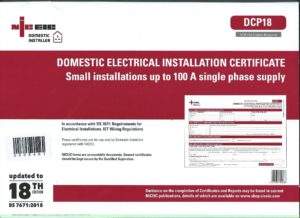 A full EIC has signed declaration boxes for key aspects of “Design”, “Construction”, “Inspection & Testing” of an installation. With smaller projects, or domestic wiring, typically all of these aspects are carried out by a single person, so a single signatory form is also used. The signed declarations confirm that the work undertaken complies with current wiring regulations. It will normally be several A4 sheets, and include details of the property, incoming supplies, method of earthing, protective measures adopted, confirmation of installation methods and cable types and full test results for all amended circuits.
A full EIC has signed declaration boxes for key aspects of “Design”, “Construction”, “Inspection & Testing” of an installation. With smaller projects, or domestic wiring, typically all of these aspects are carried out by a single person, so a single signatory form is also used. The signed declarations confirm that the work undertaken complies with current wiring regulations. It will normally be several A4 sheets, and include details of the property, incoming supplies, method of earthing, protective measures adopted, confirmation of installation methods and cable types and full test results for all amended circuits.
Minor Works Certificate (MWC): Is a small single page version of an EIC, to certify test results  for small alterations, e.g. add a new socket or light to a circuit. It still has a signed declaration box confirming that the alteration complies with the current wiring regulations.
for small alterations, e.g. add a new socket or light to a circuit. It still has a signed declaration box confirming that the alteration complies with the current wiring regulations.
Periodic inspection report (PIR): now called an Electrical Installation Condition Report, see below.
Electrical Installation Condition Report (EICR): new name for a ‘PIR’, see periodic inspection below.
Periodic Inspection: Every installation deteriorates with age, if left unchecked an installation can become a danger to the building or its users. Fire service statistics state electrical faults as a common cause of house fires. Routine periodic inspection checks and tests on the condition of an installation should be carried out. BS7671 recommends every 10 years or change of occupancy for private domestic dwelling. (or 5 years for a rented dwelling). The results should be noted on an EICR and left with the property owner and a durable label on the fuse box should give next recommended inspection date. Tests include; Earth continuity, Polarity, Insulation Resistance, Correct cable and protective devices for loads and demand of each circuit, Physical condition of switchgear and accessories, Labels and identification of circuits, switches and conductors, Supply characteristics and bonding etc.
A periodic inspection is a sample check of an installation with agreed limitations due to the fact that some installed items may no longer be accessible. Concealed cables under floors and in walls cannot be visually checked. Some accessories may have been made inaccessible due the decoration or fabric of the building. Without ripping a building apart it is impossible to verify if all cables are routed through recognised safe zones. These should have been certified on the original installation certificate when the circuits were installed. Unfortunately on some older installations previous documents and certificates are no longer available, (or were never issued to start with).
Because of the limitations a periodic inspection cannot verify that an installation fully complies with BS7671. But the inspector carrying out the investigations will give an overall assessment that an installation is either ‘satisfactory’ or ‘unsatisfactory’ for continued use. Where anomalies are identified the observations are listed and coded according to their severity: ‘C1’ immediate danger present, ‘C2’ potentially dangerous, ‘C3’ improvement recommend, ‘FI’ further investigation required.
A full inspection will typically take half to a full day for an average domestic property, dependant upon the number of circuits. Further details about Inspection and testing and various report codes can be found in the Electrical Safety Councils Best Practice Guides No4. Which can be downloaded via the following link;
https://www.electricalsafetyfirst.org.uk/electrical-professionals/best-practice-guides/
If you are considering moving house it is good practice to arrange for an electrical inspection to be done on the proposed new house if there are no existing up to date certificates available.
-{page end 20Sept20}-



